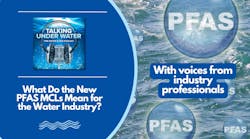This year, 2024, marks the finish line for EPA’s PFAS Strategic Roadmap, which spelled out a comprehensive plan to protect Americans from PFAS’ severe health effects by restricting and remediating the contaminant in the environment.
Soon, drinking water plants across the U.S. will be responsible for treating six PFAS chemicals, including perfluorooctanoic acid (PFOA) and perfluorooctanesulfonic acid (PFOS), if found at concentrations above a historically low 4 parts per trillion (ppt), the equivalent of one water droplet in five Olympic-sized pools.
While the roadmap prioritized drinking water to ensure consumer health, it also takes a comprehensive approach to the contamination that will considerably change how publicly owned treatment works (POTW) operate. POTWs include wastewater treatment facilities as well.
Under the Comprehensive Environmental Response, Compensation, and Liability Act (CERCLA), more commonly known as Superfund, EPA is in the process of designating PFOA and PFOS as “hazardous substances.” The designation will have a precipitating effect on the many industries and policies that EPA oversees, potentially having immediate consequences on POTWs nationwide.
Designation of PFAS Under CERCLA and RCRA
In April 2023, EPA requested public input regarding the potential designations of PFOS and PFOA, as well as their salts and structural isomers, as hazardous substances under CERCLA. This proposed rulemaking would increase transparency around the releases of these chemicals to help hold polluters accountable for contaminations.
The proposed rule would require discharging entities to immediately report future releases of PFOA and PFOS that meet or exceed the reportable quantity, one pound within a 24-hour period, to the National Response Center, state or Tribal emergency response commission, and local emergency responders. Entities would not be required to report past releases of these substances.
The proposed designation of PFOA and PFOS as hazardous substances is based on significant evidence that they present a substantial danger to human health, welfare and the environment.
PFOA and PFOS can accumulate and persist in the human body for long time periods. Evidence from laboratory animal and human epidemiology studies indicate that exposure to PFOA and PFOS can cause cancer, reproductive and fetal developmental issues, cardiovascular, liver, kidney, and immunological health concerns.
In fact, based on these toxic effects, EPA recently proposed adding nine PFAS compounds, including PFOA and PFOS, to the list of “hazardous constituents” under the Resource Conservation and Recovery Act, (RCRA), which would require those compounds to be treated as hazardous waste.
In a similar localized approach to how they approached PFAS drinking water standards, a number of states have begun considering regulations for PFAS in wastewater ahead of federal guidelines. Maine, for example, prohibits spreading PFAS-laden sludge and sludge-derived compost as fertilizer, which has forced wastewater POTWs into more costly disposal solutions for their biosolids.
At the same time, neighboring New Hampshire has authorized wastewater POTWs to require upstream dischargers to test for PFAS in their effluent discharge. Historically, testing efforts like these often precede regulatory action.
States such as Illinois, Maryland, Minnesota, Rhode Island and Virginia are also either considering or implementing steps and guidelines for PFAS in wastewater and biosolids.
How CERCLA and RCRA Designations Affect POTWs
If PFOA and PFOS are designated hazardous substances or constituents, the effects will be swiftly felt in all industries regulated by EPA. The designation would allow EPA, state regulators, and private citizens to hold dischargers and others responsible for PFOS and PFOA contamination, even if they had no role in creating it.
Recognizing that POTWs are not producers of PFAS chemicals, EPA has announced it will instead focus its enforcement efforts on manufacturers and producers of PFAS. However, this unofficial policy could change at any time and does not exempt POTWs from being legally pursued by private citizens and state governments. That would require Congress to amend CERCLA to exempt POTWs and other passive receivers of PFAS from CERCLA requirements, which does not appear to be on the horizon.
The Roadmap also includes a biosolids assessment that is anticipated to be released in the winter of 2024. State governments concerned about the role of biosolids in spreading PFAS contamination have already started to consider bans on land application of biosolids to protect agricultural lands that produce crops and livestock for human consumption.
Maine has already enacted such a ban, as part of a comprehensive legislative effort to limit exposure to PFAS. This has impacted Maine POTWs who were previously able to cost-effectively offload their biosolids to local farms, forcing them to dispose of their biosolids in more costly ways, like landfills.
The Roadmap has eyes on landfills as well. Similar to POTWs, landfills passively receive PFAS-laden refuse.
Testing of more than 200 landfills nationwide found that 95% of landfill leachate contained PFAS, with 63 different PFAS discovered and average concentrations for individual compounds as high as 14,000 ppt. Under comprehensive approaches to restricting PFAS, landfills may also be required to limit PFAS in leachate, potentially raising the cost of disposing biosolids in the future as landfills invest in treatment equipment. Of course, many POTWs treat landfill leachate, and already face the prospect of additional costs as a result.
There are technologies on the market that remove and destroy PFAS, which can keep wastewater plants compliant with CERCLA and other regulatory requirements, reduce contamination risk, and protect the health of communities and their surrounding environments. However, treatment costs and the potential legal liability could disrupt utility and city budgets, making the proper steps to remove contamination unattainable for often underfunded POTWs.
How a Proactive Wastewater District is Taking Action
As the public and regulators shift their attention towards wastewater, many systems are looking to retain counsel and file a lawsuit against PFAS manufacturers to seek cost recovery for their PFAS contamination and treatment. These systems have chosen to rely on specialized legal counsel who can advise them based on their utility’s unique needs.
This approach proved effective in the case of drinking water suppliers, whose lawsuits against PFAS manufacturers over the past several years resulted in two proposed settlements, from 3M Company and the DuPont group of companies, providing a total of more than $12 billion to clean up PFAS in drinking water.
York Sewer District in Maine, for example, discovered PFAS in its wastewater system while testing its biosolids as part of the Maine Department of Environmental Protection’s new requirements. The district determined that household items, such as non-stick cookware, cleaning, and stain-resistant products were the source of contamination — rather than local drinking water supplies, where PFAS has never been detected.
Concerned about the impact of these chemicals to the community’s infrastructure and finances, in late 2023, York Sewer District hired SL Environmental Law Group to sue 3M, DuPont, and other PFAS manufacturers to recover the costs the district would incur as a result of PFAS in its effluent and biosolids. The aim of the lawsuit, which is part of the same ongoing AFFF multi-district litigation against PFAS manufacturers that produced the drinking water settlements, is to recover funds to keep the district in regulatory compliance and protect public health without financially burdening its ratepayers.
Next Steps
Holistic PFAS regulations aim to reduce the harm these chemicals can cause and have inflicted for generations. But the encompassing approach to removing PFAS from the environment has substantial financial implications for water and wastewater providers nationwide.
While some federal and state funding may be available to these providers, industry cost estimates reveal these sources will likely be insufficient. Litigation remains an attractive funding route for a number of wastewater utilities, if they will become burdened by additional testing, reporting, and treatment requirements, and potential lawsuits from private parties and state governments.
To prepare for this regulatory shift, wastewater operators can begin combating PFAS contamination in their community by testing effluent and biosolids for PFOA and PFOS. Testing data gives utilities the information they need to begin their journey to identifying PFAS sources in their community, working with regulators and local industry to find short- and long-term pretreatment solutions, and substantiating litigation claims against big-name polluters responsible for the contamination.







